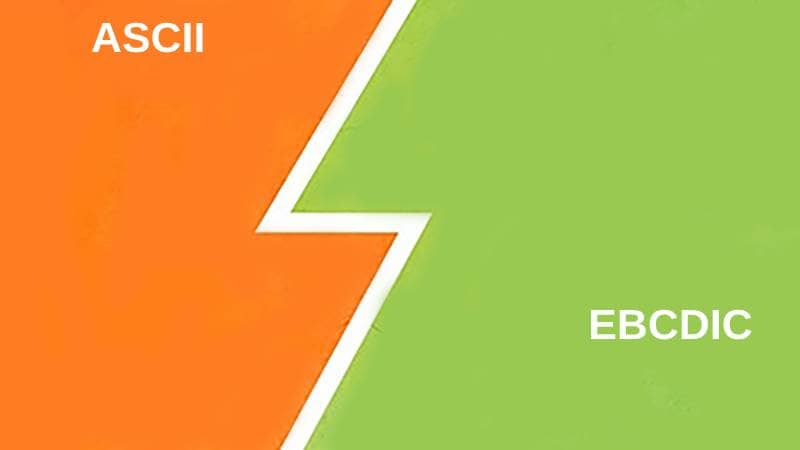Code is the power of our digital World. Coding is the process of intercommunication between human beings and Computers. The method of assigning binary codes to represent data. ASCII and EBCDIC are commonly used character coding systems for encoding text. ASCII codes represent text in computers, telecommunication devices, and other electronic devices.
ASCII vs EBCDIC
The main difference between ASCII and EBCDIC is that ASCII uses standard 7 bits per character, which is compatible with modern technologies. On the other hand, EBCDIC uses 8 bits per character, used for the IBM machine and in a text file to represent numeric and alphanumeric characters.

ASCII is shorted from the American Standard Code for Information Interchange, ways of representing digits, alphabets, and special symbols. The digits can be 1, 2, 3, etc., while the letters are a, b, c, d, A, B, C, etc. The symbols are characters like! $, & and #. It is used in programming, data conversions, graphic arts, and text files.
EBCDIC is shorted for Extended Binary Coded Decimal Interchange Code; it is a very popular character coding system due to mainly being used in IBM machines to represent digits, alphabets, and special symbols. EBCDIC uses 8-bit code, which means it can represent a total of 256 alphanumeric and special characters.
Comparison Table Between ASCII and EBCDIC
| Parameter of comparison | ASCII | EBCDIC |
| The number of Bits uses | ASCII uses seven bits to represent character | EBCDIC is used eight bits to represent character |
| The number of characters represents | ASCII represents a total of 128 characters | EBCDIC represents a total of 256 characters |
| Application | ASCII is mainly used in telecommunication devices | EBCDIC is mainly used on IBM machines |
| Efficiency | ASCII is more efficient in coding system | EBCDIC is not much efficient in coding system |
| Compatibility encoding | ASCII has compatibility with the modern encoding system | EBCDIC is not compatible with the modern coding system |
What is ASCII?
ASCII is shorted from the American Standard Code for Information Interchange and is a standard character encoding System. The American Standards Association committee developed it, also called the X3 committee. ASCII looks between character symbols and digital bit patterns. This helps devices to communicate with each other like written language. The work to develop the ASCII standard started in May 1961 and was finally published in 1963 and revised in 1967.
ASCII codes represent text in computers, telecommunication devices, and other electronic devices. It uses 7 bits per character, which means it can represent 2^7 or 128 characters. Character in ASCII code includes Upper case letters A to Z, lower case letters a to z, numerical values 0 to 9, and some basic special symbols.
ASCII provides an understood character set for communication that is universally accepted. It converts data into computer language. For example, changing a bit in binary code using ASCII character codes will convert lowercase (a) into uppercase (A). Lowercase (a) in binary (0110 0001) and Uppercase (A) in binary (0100 0001).
It is used to represent data internally in A microprocessor. ASCII represents 128 characters only, and the drawback is that it cannot represent other languages, such as Greek and Arabic, or mathematical symbols. In ASCII, the letters are arranged in consecutive order.
What is EBCDIC?
EBCDIC is shorted for Extended Binary Coded Decimal Interchange Code, which is very popular with larger encoding systems. The coding system shows letter numbers and symbols in binary language. EBCDIC is mainly used for IBM midrange and mainframe computers. This type of coding system was developed in 1963 and 1964. EBCDIC helps to enhance the capability of binary-coded decimal code.
It uses 8 bits per character, which means it can represent 2^8 or 256 characters. Characters in EBCDIC include letters, digits, punctuation marks, and special symbols. There are some disadvantages to EBCDIC. The first problem is how to arrange the letters of the alphabet. EBCDIC groups 9 letters at a time.
It is incompatible with the modern operating system and less efficient than ASCII; however, it is still used today. EBCDIC is an 8-bit binary code for numeric and alphanumeric characters. The first four-bit group is called ‘Zone,’ which represents the character category, and the second group, called ‘Digit,’ identifies the specific characters.
Main Difference Between ASCII and EBCDIC
- The ASCII uses seven bits in the coding system to represent any character, whereas EBCDIC uses eight bits in the coding system to represent any character.
- In ASCII there is a total of 128 characters to represent, whereas in the EBCDIC there are 256 characters.
- ASCII can work with modern encoding systems like Unicode, whereas EBCDIC is an old system of coding that cannot work with modern encoding systems like Unicode.
- ASCII is more efficient in the work of coding systems, whereas EBCDIC is not as efficient as ASCII in the coding system.
- ASCII is normally used in the telecommunication system, while EBCDIC is mainly used in IBM machines.
- ASCII manages continuous requests of characters, whereas EBCDIC can manage only nine simultaneously bundled characters.
Conclusion
ASCII and EBCDIC are famous character coding systems; however, the main difference is the use of several bits. ASCII uses seven bits per character, and EBCDIC uses eight. The efficacy of these coding systems is also varying ASCII is more efficient than EBCDIC; on the other hand, when we look at the handling, ASCII comes first in number than EBCDIC, and EBCDIC is difficult to implement.
American Standard Code for Information Interchange and Extended Binary Coded Decimal Interchange Code are two encoding standards that help to handle text in the computer. However, ASCII can work with modern encoding like Unicode, but EBCDIC cannot work with the latest encoding system. Both can handle the process on the computer and make it easier for users to access the technologies per their needs.
 Samantha Nicole
Samantha Nicole